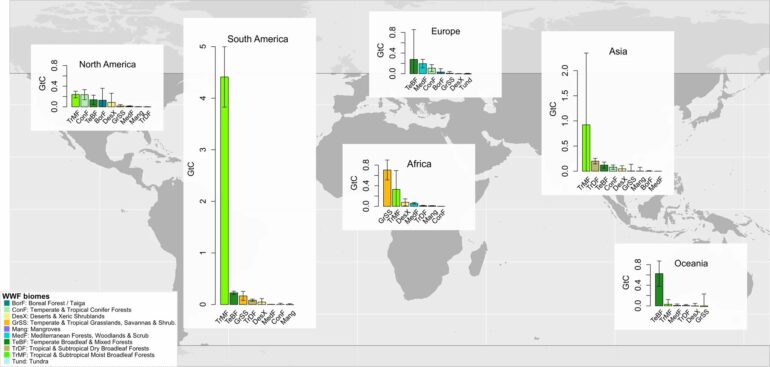A study recently published in Nature Communications by researchers at the University of Maryland (UMD), Northern Arizona University, the University of Arizona, Conservation International and more has found that worldwide protected forests have an additional 9.65 billion metric tons of carbon stored in their aboveground biomass compared to ecologically similar unprotected areas—a finding that quantifies just how important protected areas are in our continued climate mitigation efforts.
This study used the highly accurate forest height, structure and surface elevation data produced by NASA’s Global Ecosystem Dynamics Investigation (GEDI, PI Ralph Dubayah, UMD). The team of researchers compared protected areas’ efficacy in avoiding emissions to the atmosphere with unprotected areas’ ability to do the same and tested the assumption that protected areas provide disproportionately more ecosystem services—including carbon storage and sequestration—than non-protected areas.
“We have never had these 3D satellite datasets before, so we have never been able to map forest carbon accurately at this scale. Analyzing the data to discover the magnitude of avoided emissions in protected areas shines yet another light on the global importance of forest conservation,” said UMD Assistant Professor Laura Duncanson, lead author of the study. “We look forward to continuing this work to monitor the future success of protected areas for preserving carbon.”
The biggest, most climate-positive impact the researchers observed came from the protected, moist broadleaf forest biome in the Brazilian Amazon, with Brazil contributing 36% to the global signal.
Another key finding was that the amount of aboveground biomass—the dry mass of woody matter in vegetation that stands above the ground—gained from protected areas is roughly equivalent to one year of annual global emissions from fossil fuels.
Previous attempts to quantify protected areas’ biomass content had high uncertainties and/or biases, as past satellite biomass products are known to saturate in high biomass forests, such as old-growth protected areas. GEDI data helped the researchers overcome these limitations.
The researchers specifically used height, cover, Plant Area Index (PAI), and Above Ground Biomass Density (AGBD) products from the first 18 months of GEDI mission data, which was collected between April 2019 and September 2020. In total, the researchers—which also include UMD’s Mengyu (Amber) Liang, Veronika Leitold and John Armston—analyzed more than 400 million 3D structure samples and matched each protected area to ecologically similar unprotected areas based on climate, human pressure, land type, country and other factors.
“These results are novel in that they provide the first, long-anticipated evidence that protected areas are effectively sequestering a lot more CO2 from the atmosphere than otherwise similar but degraded areas that surround them,” said Scott Goetz, Regents’ Professor in the School of Informatics, Computing, and Cyber Systems at Northern Arizona University and co-author of the study. “They were only possible because of systematic spaceborne measurements of canopy structure and aboveground biomass from the GEDI Lidar mission.”
The researchers’ study highlights the urgency of protection and restoration for biodiversity conservation and climate change mitigation, as emphasized by the latest report by the Intergovernmental Panel on Climate Change (IPCC).
The IPCC found that nature-based solutions such as reducing the destruction of forests and other ecosystems, restoring them and improving the management of working lands, such as farms, are among the top five most effective strategies for mitigating carbon emissions by 2030.
“Protected areas are an essential part of the conservation toolkit. They confer enormous benefits in the form of living carbon, essential to mitigate climate change’s worst effects,” said Patrick Roehrdanz, director of Climate Change and Biodiversity at Conservation International. “This research reflects the importance of the Convention on Biological Diversity target—of achieving 30 percent protection of all ecosystems—as an effective strategy to address more than one of the biggest environmental crises we face: biodiversity loss and climate change.”
More information:
L. Duncanson et al, The effectiveness of global protected areas for climate change mitigation, Nature Communications (2023). DOI: 10.1038/s41467-023-38073-9
Provided by
University of Maryland
Citation:
Study finds forest protection successfully leads to reduced emissions at global scale (2023, June 1)
